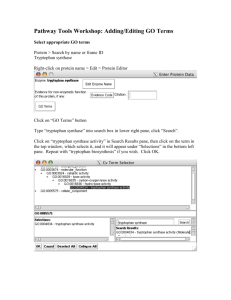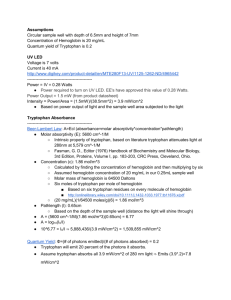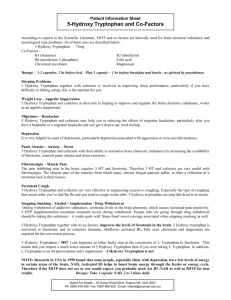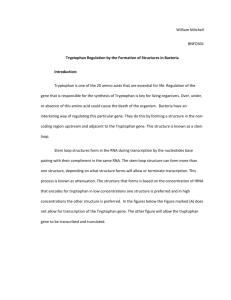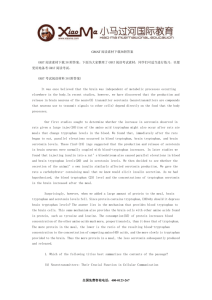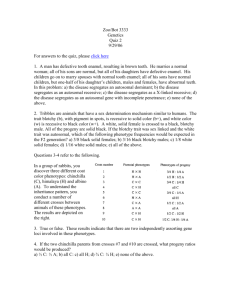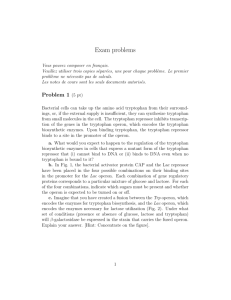Moskowitz et al.
advertisement
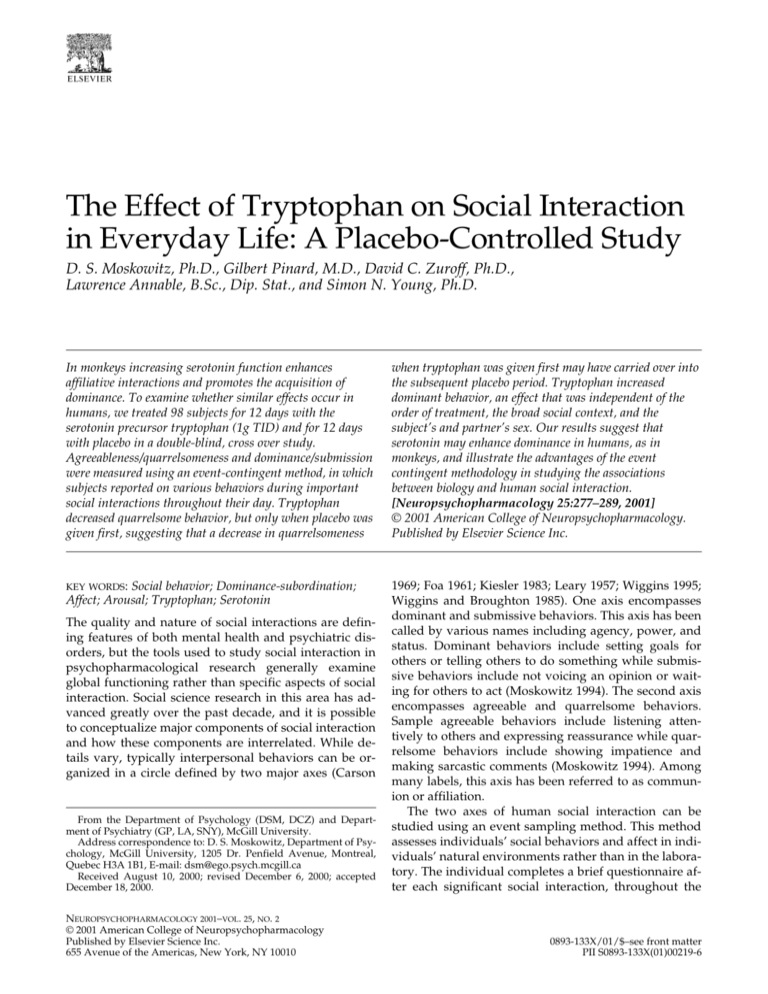
The Effect of Tryptophan on Social Interaction in Everyday Life: A Placebo-Controlled Study D. S. Moskowitz, Ph.D., Gilbert Pinard, M.D., David C. Zuroff, Ph.D., Lawrence Annable, B.Sc., Dip. Stat., and Simon N. Young, Ph.D. In monkeys increasing serotonin function enhances affiliative interactions and promotes the acquisition of dominance. To examine whether similar effects occur in humans, we treated 98 subjects for 12 days with the serotonin precursor tryptophan (1g TID) and for 12 days with placebo in a double-blind, cross over study. Agreeableness/quarrelsomeness and dominance/submission were measured using an event-contingent method, in which subjects reported on various behaviors during important social interactions throughout their day. Tryptophan decreased quarrelsome behavior, but only when placebo was given first, suggesting that a decrease in quarrelsomeness when tryptophan was given first may have carried over into the subsequent placebo period. Tryptophan increased dominant behavior, an effect that was independent of the order of treatment, the broad social context, and the subject’s and partner’s sex. Our results suggest that serotonin may enhance dominance in humans, as in monkeys, and illustrate the advantages of the event contingent methodology in studying the associations between biology and human social interaction. [Neuropsychopharmacology 25:277–289, 2001] © 2001 American College of Neuropsychopharmacology. Published by Elsevier Science Inc. KEY WORDS: 1969; Foa 1961; Kiesler 1983; Leary 1957; Wiggins 1995; Wiggins and Broughton 1985). One axis encompasses dominant and submissive behaviors. This axis has been called by various names including agency, power, and status. Dominant behaviors include setting goals for others or telling others to do something while submissive behaviors include not voicing an opinion or waiting for others to act (Moskowitz 1994). The second axis encompasses agreeable and quarrelsome behaviors. Sample agreeable behaviors include listening attentively to others and expressing reassurance while quarrelsome behaviors include showing impatience and making sarcastic comments (Moskowitz 1994). Among many labels, this axis has been referred to as communion or affiliation. The two axes of human social interaction can be studied using an event sampling method. This method assesses individuals’ social behaviors and affect in individuals’ natural environments rather than in the laboratory. The individual completes a brief questionnaire after each significant social interaction, throughout the Social behavior; Dominance-subordination; Affect; Arousal; Tryptophan; Serotonin The quality and nature of social interactions are defining features of both mental health and psychiatric disorders, but the tools used to study social interaction in psychopharmacological research generally examine global functioning rather than specific aspects of social interaction. Social science research in this area has advanced greatly over the past decade, and it is possible to conceptualize major components of social interaction and how these components are interrelated. While details vary, typically interpersonal behaviors can be organized in a circle defined by two major axes (Carson From the Department of Psychology (DSM, DCZ) and Department of Psychiatry (GP, LA, SNY), McGill University. Address correspondence to: D. S. Moskowitz, Department of Psychology, McGill University, 1205 Dr. Penfield Avenue, Montreal, Quebec H3A 1B1, E-mail: dsm@ego.psych.mcgill.ca Received August 10, 2000; revised December 6, 2000; accepted December 18, 2000. NEUROPSYCHOPHARMACOLOGY 2001–VOL. 25, NO. 2 © 2001 American College of Neuropsychopharmacology Published by Elsevier Science Inc. 655 Avenue of the Americas, New York, NY 10010 0893-133X/01/$–see front matter PII S0893-133X(01)00219-6 278 D.S. Moskowitz et al. day. Abundant evidence has accumulated demonstrating the reliability and validity of methods for sampling interpersonal behavior and affect in everyday life (Csikszentmihalyi and Larson 1987; Diener and Emmons 1984; McAdams and Constantian 1983; Moskowitz 1994). While behavior along the axes varies greatly from one social interaction to the next, aggregation of behaviors in events across several days provides measures with substantial temporal stability (Brown and Moskowitz 1998). The event-contingent recording procedure (Wheeler and Reis 1991) used in the present study has several advantages. Interpersonal situations are sampled throughout the day, providing reports of behavior and affect at home and at work. Reports of behavior and affect are recorded close in time to their occurrence, so retrospective biases are minimized. It is possible to construct behavior and affect scores for time periods of specified lengths, such as morning, afternoon, and evening, or a day, or a week. Previous research using this method has demonstrated the concurrent relation between interpersonal behaviors and affect valence. Most individuals feel positively valenced affect when engaging in agreeable behaviors and negatively valenced affect when engaging in quarrelsome behaviors and in submissive behaviors (Moskowitz and Côté 1995). One type of social interaction in which the role of a specific neurotransmitter system, serotonin, is seen as primary is pathological aggression. An extensive literature on experimental animals indicates that brain serotonin has an important inhibitory effect on aggressive behavior (Eichelman 1990; Valzelli 1984; Eichelman 1993). A much less extensive literature supports the idea that serotonin may also modulate aggressive responding in humans (Åsberg et al. 1987; Virkkunen and Linnoila 1993). Low levels of the serotonin metabolite 5-hydroxyindoleacetic acid (5-HIAA) have been found in the cerebrospinal fluid (CSF) of aggressive patients. Low CSF 5-HIAA is also associated with the self-directed aggression of suicide, and in particular violent and successful suicides. While the CSF 5-HIAA results are correlational and do not necessarily imply cause and effect, results using the acute tryptophan depletion technique indicate that a lowering of tryptophan, and thus a lowering of brain serotonin synthesis (Nishizawa et al. 1997), increases aggression in humans during laboratory tests (Pihl et al. 1995; Cleare and Bond 1995; Moeller et al. 1996). Administration of tryptophan to treat pathological aggression has been tested in two studies. In the first, tryptophan decreased uncontrolled aggressive behavioral events relative to placebo in aggressive patients who had not responded well to neuroleptics (Morand et al. 1983); in the second, tryptophan did not decrease aggressive events but, relative to placebo, decreased the need for neuroleptics (Volavka et al. 1990). The therapeutic efficacy of tryptophan in aggression is consistent with monkey data demonstrating that low- NEUROPSYCHOPHARMACOLOGY 2001–VOL. 25, NO. 2 ering serotonergic function in monkeys tends to increase aggression (Chamberlain et al. 1987; Raleigh et al. 1980; Raleigh and McGuire 1991; Raleigh et al. 1991). Interestingly, the monkey data indicated that serotonin function alters affiliative behaviors in the opposite way to aggression. Thus, lowering serotonin decreased affiliative behaviors, while increasing serotonin function increased affiliative behaviors. The association between low serotonin and aggression in humans has often been thought of as one indication of the inhibitory effect of serotonin on a number of different types of responses (see e.g. Coccaro 1992; Mann 1995). However, the data from monkeys suggest that, at least in a species that shares 92% of its genes with humans (King et al. 1988), increasing serotonin function can have specific effects that increase one form of social behavior. There is little human data on serotonin and affiliative interactions. Specific serotonin reuptake inhibitors have a therapeutic effect in patients with social phobia (Katzelnick et al. 1995; Jefferson 1995); however, this may be related to relief of anxiety rather than direct potentiation of social interaction. In a healthy sample, a selective serotonin reuptake inhibitor, paroxetine, increased affiliative social behavior during a cooperative dyadic task when administered after one week of paroxetine treatment, but not after four weeks of treatment (Knutson et al. 1998). As previously described, the main dimensions of human social interaction include affiliative behaviors and also the status-related behaviors of dominance and submission. Thus, it is of interest that serotonin has also been related to dominant and submissive behaviors in monkeys. In monkeys there is a two way interaction between dominance and serotonin (Higley et al. 1996a; Raleigh and McGuire 1991; Raleigh et al. 1984; Raleigh et al. 1983). In vervet monkey troops the alpha male has high platelet and brain serotonin, and these levels fall when dominance is lost. Conversely, raising brain serotonin function with tryptophan or fluoxetine promotes acquisition of dominance in males (Raleigh and McGuire 1991). Dominant and affiliative behaviors may facilitate one another. In vervet troops it is affiliative alliances with females (enhanced in this situation by high serotonin) that enable a male to achieve dominant status (Raleigh and McGuire 1989). The monkey data raise several questions about the possible effects of serotonin on human social interactions. If low serotonin has negative consequences on aspects of social behavior, could high serotonin increase positive social behaviors, and could serotonin levels be related to social interactions in the healthy population, not just in patients with psychopathology? The purpose of the present study was to examine the effect of tryptophan, given to raise brain serotonin, on social interactions and affect in healthy subjects in everyday life. In particular we examined whether increasing serotonin NEUROPSYCHOPHARMACOLOGY 2001–VOL. 25, NO. 2 would decrease quarrelsome behaviors, increase agreeable behaviors, and increase dominant behaviors. SUBJECTS AND METHODS Subjects The study was approved by the Research Ethics Board of the Royal Victoria Hospital, McGill University Health Centre. All participating subjects signed a consent form after the study had been explained to them. Participants were recruited from the community. Advertisements in newspapers offered Can $150 to adults who were working at least 30 hours per week to take part in a study of the pharmacological effect of a dietary component on social interaction. The requirement concerning employment was established to ensure that individuals participated in a range of situations with a range of social interaction partners. There were 58 men and 64 women who appeared to meet screening requirements based on information provided in the telephone responses to the advertisements. These individuals were invited to initial sessions in which they were further screened by a psychiatrist (see below). Of these, 51 men and 49 women passed all screening requirements and began the study. More women than men were disqualified, because use of estrogen medications is considered a contraindication for the use of tryptophan. One man and one woman dropped out, both after only a few days in the study; they were both on placebo. Thus, 50 men and 48 women completed the study. Their median age was 33 years (range: 18–67 years). The intent of the study was to include a reasonably representative sample of the population, excluding those individuals with psychiatric illnesses characterized by markedly lowered mood, those taking psychotropic drugs, or those with any condition which is considered a contraindication for the use of tryptophan. All participants were interviewed by a psychiatrist (GP) who assessed their current mental state and their suitability to receive tryptophan. Initial level of depression was evaluated using the Beck Depression Inventory (BDI) and by the collaborating psychiatrist. To detect any depression that might develop during the study, each person completed a BDI after two weeks and at the end of the study. Participants who initially scored above 10 (mild depression and above) (Beckham and Leber 1985) were not included in the study. No individual who was initially included in the sample obtained an elevated BDI score on subsequent assessments. Treatment The treatment was tryptophan 1g TID, or identical placebo, taken with meals. This dose of tryptophan is Effect of Tryptophan on Social Interaction 279 about three times the normal daily dietary intake, which is about 1 g/day (Sainio et al. 1996). The 3g daily dose was chosen because (i) this dose should keep tryptophan hydroxylase close to saturation, and thus serotonin synthesis maximized, for most of the day (Young and Gauthier 1981), and (ii) the same dosage, when given to mild to moderately depressed outpatients, was more effective than placebo in treating depression, but produced no more side effects than placebo (Thomson et al. 1982). Tryptophan was given with meals for two reasons. First, the rise of plasma tryptophan after tryptophan administration is large and rapid (Yuwiler et al. 1981). Competition for entry into the brain between tryptophan and the other large neutral amino acids contained in the meal (Wurtman et al. 1981) would be greatest when plasma tryptophan was at its greatest. Therefore, giving tryptophan with meals would tend to diminish the fluctuations in brain tryptophan. Second, giving tryptophan with meals tends to diminish nausea associated with tryptophan ingestion. The tryptophan preparation used was Tryptan™, from ICN Canada. ICN Canada provided Tryptan™ and placebos that were identical in appearance. Design Participants collected event-sampled data for 28 days under a two-period cross-over design. Half the participants were assigned at random to take tryptophan for 12 days. There was then a washout period of no drug for two days. Then these participants took a placebo for another 12 days, after which there was a no-drug period of two days. The other half of the sample took a placebo for 12 days, had a 2-day washout period, took tryptophan for 12 days, and then ended with a 2-day washout period. The 2-day washout period at the end of the study was included to ensure that there were no adverse consequences (e.g., a substantial change in affect) after removal from the tryptophan. The 12-day period was selected to ensure high reliability in the assessment of affect and behavior. The reliability of these measures across days increases with aggregation of days up to 12 days (Brown and Moskowitz 1998). Reliability across days then asymptotes and does not increase with greater aggregation. Procedure The study was first explained to the participants during the initial telephone call responding to the advertisement. At the initial meeting, participants met with the psychiatrist and with the research assistant who again informed participants that they would be completing record forms to monitor their social interactions every day for 28 days. Participants were asked to complete a form for each significant interaction up to a maximum 280 D.S. Moskowitz et al. of 10 forms per day. A significant interaction was defined as an interaction lasting at least five minutes; interactions could occur face-to-face or by telephone. Participants were asked to complete the form as soon as possible after the social interaction occurred. If individuals had more than 10 interactions, they were asked to disperse the completion of the forms throughout the day. Participants mailed each day’s forms on the day following the completion of the forms. In the present study, participants completed an average of six forms per day. At the end of the first meeting, participants were given the forms and tablets for the first two weeks of the event-sampling period. Participants attended two additional meetings in the laboratory. The second meeting occurred at the end of the first two weeks of the event sampling period. At this meeting, they were given the second two weeks of forms and tablets and questioned about possible side effects of the tryptophan or placebo. They attended a third meeting at the end of the 28-day period to provide information about side effects, to complete final questionnaires about their participation in the study, to be thanked, to receive their monetary compensation, and to answer their questions. Record forms. The record form provided a list of behaviors and affects that could occur during a social interaction and requested information about the situation in which the social interaction occurred. For example, the participant was asked if the situation was at work, at home, or in another setting. The participant was asked to indicate who was involved in the social interaction: romantic partner, friend, acquaintance, supervisor, co-worker, supervisee, other. The participant was also asked whether alcohol was consumed during the hour before the social interaction. Behaviors. There were 46 behavior items. Examples of items representing agreeableness were: “I smiled and laughed with others,” “I compromised about a decision,” “I complimented or praised the other person,” and “I pointed out to the others where there was agreement.” Quarrelsome behaviors were represented by items such as “I made a sarcastic comment,” “I gave incorrect information,” “I showed impatience,” and “I raised my voice.” Dominance corresponded to items such as, “I asked the other to do something,” “I voiced an opinion,” and “I set goals for the other.” Examples of items representing submissiveness were: “I gave in,” “I avoided taking the lead or being responsible,” and “I did not express disagreement when I thought it.” For a complete list of items, see Moskowitz (1994). Each dimension of behavior is represented by 12 items in the pool of items. Of the pool of 46 behaviors, one behavior is used for both the dominance and the quarrelsome scales (i.e. “I criticized the other”), and one behavior is used for both the submissiveness and the NEUROPSYCHOPHARMACOLOGY 2001–VOL. 25, NO. 2 agreeableness scales (“I went along with the other”). The overlap in scale items is not a problem, because items on one axis of the interpersonal circumplex are expected to have varying values on the other axis of the circumplex. Accordingly, it is theoretically plausible that one behavior reflects both dominance and quarrelsomeness and that another behavior reflects both submissiveness and agreeableness. Participants were asked to complete one form for each social interaction. Participants use the form to indicate which of the behaviors listed they had engaged in during the interaction. Four forms were used, because previous work indicated that when participants were given the same form to complete every day, they quickly adopt a response set of checking the same behaviors for every interaction. Each dimension of behavior was represented by three behavior items on each form. The forms were rotated daily; participants completed Form 1 on Day 1 for all interactions on that day, Form 2 on Day 2, Form 3 on Day 3, Form 4 on Day 4, and then the rotation was begun again and repeated for the 28 days of data collection. The pool of behaviors representing dominance, agreeableness, submissiveness, and quarrelsomeness were divided equally among the four forms. Construction of behavior scores. There were three steps in the construction of the scale scores for a specified event. First, a score for each scale was calculated by dividing the number of behavior items endorsed on a scale (between 0 and 3) by the number of items that could have been endorsed on that scale (3). Second, an ipsatizing mean was constructed by calculating the mean number of items endorsed (e.g., between 0 and 12) divided by the number of items on the form (12). Third, ipsatized scores were constructed by subtracting the ipsatizing mean from each scale score. Thus, an ipsatized behavior score reflects the frequency with which behaviors corresponding to the behavioral dimension are checked adjusted for a participant’s general rate of behavior. The ipsatizing procedure controls for response sets (e.g., the tendency to check many items or few items). Since this procedure produces scores which are fractions, each score was multiplied by a constant of 100 for the purpose of presenting means. Affect Grid. To maximize compliance, all questions concerning an interaction were combined onto one side of an 811 in. sheet of paper. The need to minimize space required for the presentation of questions while obtaining information about both the valence and extent of arousal of affect led to the use of the affect grid. The affect grid is a 1-item measure which assesses both valence and arousal (Russell et al. 1989). Using a 99 rectangular grid of squares, the participant was asked to indicate the extent to which the person was feeling pleasure-displeasure on the horizontal dimension of the NEUROPSYCHOPHARMACOLOGY 2001–VOL. 25, NO. 2 grid, and the extent of arousal-sleepiness on the vertical dimension of the grid. The affect grid has previously been used to assess mood in a daily sampling study occurring over a 2-month period (McFarlane et al. 1988). The affect grid is considered to be a particularly useful tool when the time needed to make an assessment of affect must be minimized, as in the completion of the record forms in an event-sampling study. Construction of affect scores. The arousal and valence scores on the affect grid completed on each form were used to measure arousal and affect valence during a specific event. Reliability and validity of the measures. There is considerable evidence for the reliability and validity of the specific procedure used. High reliability coefficients among the behavior items (internal consistency) on each scale have been found in two samples (Brown and Moskowitz 1998; Moskowitz 1994). The scales have high stability when aggregated over a 12-day period (Brown and Moskowitz 1998). The pattern of correlations among the behavior scales correspond to structural predictions based on the interpersonal circumplex. The behavior scales have demonstrated convergent validity and discriminant validity with more traditional questionnaire measures (Côté and Moskowitz 1998; Moskowitz and Côté 1995; Moskowitz 1994). The behavior scales are sensitive to predicted changes due to situational variations in social status (Moskowitz et al. 1994). The reliability and validity of the affect arousal and affect valence scores from the affect grid has been demonstrated in a series of studies (Russell et al. 1989). These studies demonstrated (1) agreement among raters in the use of the scale to evaluate the qualities of stimuli such as emotion words and facial expressions of emotions, (2) convergent and discriminant validity in individuals’ use of the affect grid to rate pictures of facial expressions of emotions, and (3) convergent and discriminant validity of the affect grid with two other self-report measures of current mood. The affect grid has been used to detect differences in emotion recognition in patients with right hemisphere and left hemisphere focal brain damage (Mandal 1996). The affect grid is sensitive to laboratory manipulations of affect (Eich 1995). Data Analysis Data were analyzed after the exclusion of all data collected within one hour of the ingestion of alcohol (4.7% of the interactions), because alcohol can influence social interactions. Inclusion of data collected under the influence of alcohol would increase the variance of the data. Furthermore, alcohol might interact with the effect of tryptophan. Data collected after ingestion of alcohol will be the subject of a separate report. Condition (placebo vs. tryptophan) was a withinsubjects factor, with multiple observations nested Effect of Tryptophan on Social Interaction 281 within condition. Order (placebo first vs. tryptophan first) was a between-subjects factors. Because subjects differed in the number of social interactions they reported, the data could not be analyzed using conventional repeated measures analysis of variance (ANOVA). Instead, we conducted multilevel analyses using version 6.12 of the program Proc Mixed (SAS Institute 1997). Multilevel analyses, also referred to as hierarchical linear models, random regression models, and mixed models (Kreft and De Leeuw 1998), differ from ANOVA in several ways. Because models are evaluated using maximum likelihood estimation rather than least squares, subjects are not required to have equal numbers of data points. In addition, multilevel models can be specified with random (i.e., effects that vary over participants) as well as fixed effects for the predictor variables. There were four independent variables: sex, order, condition, and (time) period. Period divided the 12 days of tryptophan or placebo administration into four blocks of three days. In Bryk and Raudenbush’s (1992) terminology, sex and order were Level-2, or betweensubjects, predictors; period and condition were Level-1, or within-subjects, predictors. Each model included a random component for the intercept (i.e., a random component for the individual subject). We used the default option of a compound symmetry covariance structure. When any effect was significant, we examined the data respecifying the model using an autoregressive covariance structure. All condition effects remained significant and virtually unchanged with the autoregressive structure. The degrees of freedom for F-tests were determined using the option which divides the residual degrees of freedom into between-subjects and withinsubjects portions. The results are presented in five sections. First, we tested whether the effects were constant or varied over the 12 days of testing. Second, after eliminating data from the first three days of the experiment, which appeared to have had a reactive effect on subjects’ behavior, we examined the effects of tryptophan on dominant behavior, submissive behavior, agreeable behavior, and quarrelsome behavior. Third, we tested possible moderators of the observed effects of tryptophan on behavior. Fourth, we examined the effects of tryptophan on affect arousal and affect valence. Fifth, we examined the extent to which participants remained blind to treatment and whether the conditions differed in reported side effects. RESULTS Effects of Time The first 12 days of testing were divided into four blocks of three days, as were the 12 days after the cross- 282 D.S. Moskowitz et al. over. The first three days of the study, and the first three days after the crossover, were denoted Period 1, with Periods 2 to 4 consisting of each subsequent 3-day period. To determine whether differences between the tryptophan and placebo conditions might have varied from the beginning to the end of the 12 days of their administration, we conducted multilevel analyses with two Level-2 predictors (Sex and Order) and two Level-1 predictors (Condition and Period). The dependent variables were the four interpersonal circumplex poles, and also affect arousal and affect valence. The main effects were entered first, followed by the six 2-way interactions. Finally, the Period X Sex X Condition and Period X Order X Condition interactions were entered. In this section we focus on interactions with Period that might qualify conclusions about the effects of tryptophan. The Period X Order X Condition triple interaction was significant or nearly significant for four of the six dependent variables: dominant behavior (F(3,13057) 4.11, p .01), submissive behavior (F(3,13057) 2.32, p .08), quarrelsome behavior (F(3,13057) 4.28, p .01), and affect arousal (F(3,12921) 2.93, p .05). Inspection of the means suggested that results for the first time period were discrepant from those for the remaining periods. We therefore followed up the finding of significant triple interactions by examining the Order X Condition interactions within the first time period and within the combined three subsequent time periods. For dominant behavior, the Order X Condition interaction was significant in the first time period, F(1,3492) 12.88, p .001, but not in the remaining time periods. For submissive behavior, the interaction was also significant only in the NEUROPSYCHOPHARMACOLOGY 2001–VOL. 25, NO. 2 first time period, F(1,3492) 4.61, p .05. For quarrelsome behavior, the interaction was significant in the first time period, F(1,3492) 4.74, p .05, but also significant in the remaining time periods, F(1,9480) 4.83, p .05. For affect arousal, the interaction was significant for neither the first nor the remaining time periods. The significant Order X Condition interactions during the first time period are displayed in Figure 1. Subjects who received tryptophan first reported more dominant behavior on tryptophan than on placebo; conversely, subjects who received placebo first reported more dominant behavior on placebo than on tryptophan. Stated differently, dominant behavior was higher during the first three days of the study than during the first three days after the crossover, regardless of whether subjects were taking tryptophan or placebo. Subjects also displayed less submissive behavior and less quarrelsome behavior during the first three days of the study, regardless of whether they were taking tryptophan or placebo. Although not predicted, these results suggest that entering the study, involving as it did both detailed self-monitoring of social behavior and taking tablets that might have been expected to influence social behavior, was highly reactive. Subjects appear to have responded with an initial shift in the direction of more socially desirable behavior, i.e. increased dominant behavior and decreased submissive and quarrelsome behavior. Regardless of whether this interpretation is correct, it is clear that the relation between tryptophan and behavior during the first time period was markedly discrepant from that during the remainder of the exper- Figure 1. Social behavior during the first time period (values are mean SE). NEUROPSYCHOPHARMACOLOGY 2001–VOL. 25, NO. 2 iment. We therefore decided to conduct the remaining analyses omitting the data from the first three days of the study; the three days after the crossover were also omitted to balance the number of days in the two halves of the experiment. We have included results in parentheses for effects that occurred including these omitted days. Effects of Tryptophan on Interpersonal Behavior Dominant Behavior. Dominant behavior was subjected to a multilevel analysis with four main effects (period, order, sex, and condition) and three two-way interactions (Sex X Order, Sex X Condition, and Order X Condition). None of the interactions was significant, so the model was re-estimated including only main effects. The effect of condition was significant, F(1,9482) 5.68, p .02, indicating that dominant behavior was higher under tryptophan (mean SE; 9.11 0.65) than under placebo (8.02 0.65); see Figure 2. The absence of a Sex X Condition interaction indicates that the effect of tryptophan was equivalent for men and women. (The main effect for condition on dominant behaviors was also present in the analysis including all the days of data collection; there was also a condition by order effect when using all days, indicating that the effect was present when tryptophan was given first.) To characterize the magnitude of the tryptophan effect in terms of behavioral change, we compared the difference between the estimated means for the two conditions with the difference in dominant behavior when individuals were with a boss or with a coworker. Past work (Moskowitz et al. 1994) has indicated a reliable influence of hierarchical role on dominant behavior; there was also an effect for social role in the present study, F(1, 1591) 14.63, p .0001. The mean for behavior Effect of Tryptophan on Social Interaction 283 with boss and with co-worker was estimated controlling for period, order, sex, and condition; the estimated mean for dominant behavior with the boss was 6.61 (SE: 1.3) and with the coworker was 11.35 (SE: 1.0), indicating people were more dominant when with a coworker than the boss (difference 4.74). The difference between the tryptophan and placebo means presented previously was 1.09. Comparing these differences suggests that the difference between the tryptophan condition and the control condition was approximately 23% of the difference between dominant behavior when engaging in interaction with a supervisor compared to a coworker. Having found that tryptophan increased mean levels of dominant behavior, we next tried to describe its effect in more detail. For each day of the second through fourth periods (i.e., days 4–12 after the start or after the crossover), we identified interactions with the highest level of dominant behavior. Multilevel analyses were conducted with sex and order as between subjects factors and condition and day (ranging from 4 to 12) as within subjects factors. The dependent variable was the highest level of dominant behavior displayed on each day. None of the 2-way interactions was significant. However, significant effects were found for period, F(2,1607) 11.38, p .001, and condition, F(1,1607) 5.15, p .05. The third period included the days Monday to Wednesday. The second period included the weekend days of Friday to Sunday, and the fourth period included the days Thursday to Saturday. Maximum levels of dominant behavior were higher during Period 3 (mean SE; 35.0 1.1), which comprised the beginning of the work week, than for Period 2 (30.4 1.1) or Period 4 (31.0 1.1), both of which included weekend days. The effect of condition reflected an increase in maximum daily levels of dominant behavior (33.1 Figure 2. Dominant behavior in the tryptophan and placebo conditions (values are mean SE). 284 D.S. Moskowitz et al. 1.0) under tryptophan compared to placebo (31.2 1.0). Thus, tryptophan increased mean levels of dominant behavior and also raised the peak for displays of dominant behavior. Submissive Behavior. Submissive behavior was analyzed in the same fashion as dominant behavior. There were no significant effects. (There was a significant condition by order effects when using all the days, indicating less submissive behavior when tryptophan came first.) Agreeable Behavior. The analysis for agreeable behavior revealed no significant effects. Quarrelsome Behavior. The analysis of quarrelsome behavior revealed significant effects for Period, F(2,9481) 4.75, p .01, and the Order X Condition interaction, F(1,9480) 4.83, p .05. Quarrelsome behavior was lower in the third (mean SE; 15.9 0.7) and fourth (15.4 0.8) periods than it was in the second period (14.5 0.8). The difference among periods was not predicted and is not readily interpretable. There was little difference between quarrelsome behavior under tryptophan (15.7 1.0) and placebo (15.5 1.0) when tryptophan was administered first. However, when placebo was administered first, quarrelsome behavior was less under tryptophan (15.7 1.0) than under placebo (14.3 1.0), p .05 by Tukey test. To characterize behaviorally the magnitude of the effect of tryptophan on quarrelsome behavior, we again compared the difference in conditions to that which occurred in situations with the boss and with a coworker. There was an effect for hierarchical role, F(1, 1590) 5.33, p .05, such that individuals were less quarrelsome NEUROPSYCHOPHARMACOLOGY 2001–VOL. 25, NO. 2 with the boss (mean SE: 17.11 1.17) than with a coworker (14.71 0.96), for a difference of 2.40. Comparing that to the difference in quarrelsome behavior when placebo was administered before tryptophan, indicates that the difference between conditions (difference 1.4) was more than half the difference in quarrelsome behavior when being with a boss or a coworker. We also conducted an analysis on peak levels of quarrelsome behavior comparable to the previously described analysis of peak levels of dominant behavior. The dependent variable was the highest level of quarrelsome behavior displayed on each day. A significant Order X Condition effect was found, F(1,1605) 12.03, p .001. When placebo was given first, the maximum levels of quarrelsome behavior were higher on placebo than on tryptophan, p .001 by Tukey test. The maximum level of quarrelsome behavior during the placebo condition when placebo was given first was also higher compared to placebo given after tryptophan, p .05 by Tukey test (see Figure 3 for means). These results suggest that the ceiling for quarrelsome behavior decreased while on tryptophan, and the effect was carried over into the placebo period when placebo was administered after tryptophan. Contextual Moderators of the Effect of Tryptophan on Dominant and Quarrelsome Behavior We wished to determine whether the increased dominant behavior displayed under tryptophan was a general phenomena or might be moderated by interpersonal context. A series of dichotomous variables was generated to represent whether each interaction took place at work or at home, with a male or female partner, Figure 3. Maximum daily level of quarrelsome behavior during the tryptophan and placebo conditions (values are mean SE). NEUROPSYCHOPHARMACOLOGY 2001–VOL. 25, NO. 2 and with a romantic partner or someone else. Multilevel analyses were then conducted with dominant behavior as the dependent variable and period, sex, order, the contextual variable, and the interaction of condition and the contextual variable as predictors. Sample sizes for these analyses varied because not all subjects interacted with each type of partner. In no case was the Context X Condition interaction significant. Thus, there was no evidence that the effect of tryptophan was moderated by interpersonal context; in particular, we found no evidence that the broad social context (work vs. home), the partner’s sex, or the partner’s relationship status moderated the effect of tryptophan on dominant behavior. Multilevel analyses including a Condition X Order X Context effect were conducted to examine whether interpersonal contexts moderated the Condition X Order effect for quarrelsome behavior. There was no evidence that the Condition X Order effect was moderated by social context, partner’s sex, or the partner’s relationship status. Effects of Tryptophan on Affect Arousal and Affect Valence Affect Arousal. Multilevel analyses of the affect variables were conducted analogous to those for social behavior. For affect arousal, significant effects were found for Period, F(2,9379) 6.55, p .01, and the Sex X Condition interaction, F(1,9379) 5.09, p .05. The period effect indicated that arousal was higher during the fourth period (Mean SE; 5.71 0.08) than during the second (5.57 0.08) and third (5.61 0.08) periods. Tryptophan had no effect on affect arousal in men (Placebo, 5.53 0.11; Tryptophan, 5.54 0.11), but decreased arousal in women (Placebo, 5.79 0.12; Tryptophan, 5.66 0.12). Affect Valence. The only significant effect in the analysis of affect valence was for period, F(1,9377) 24.7, p .001. Affect was more positive during the second (mean SE; 6.35 0.09) and fourth periods (6.25 0.09) than during the third period (6.04 0.09). The second period included the weekend days of Friday to Sunday, and the fourth period included the days Thursday to Saturday. The third period included the days Monday to Wednesday. It is perhaps not surprising that the period falling in the beginning of the work week was characterized by less positively valenced affect than the periods involving weekend days. Assessment of the Blind To assess to what extent subjects remained blind to the treatments, subjects were asked at the final session in which period they were on tryptophan and in which period they were on placebo. Of the women, 72% were Effect of Tryptophan on Social Interaction 285 correct in guessing condition; this was significantly different from chance, p .05. Of the men, 43% guessed correctly; this was not significantly different from chance. Both men and women engaged in more dominant behavior on tryptophan with the men remaining blind to condition; thus, the unblinding of some women appears not to have altered the main results. Side Effects Very few side effects were reported. Table 1 presents the incidences of side effects on tryptophan and placebo. A test of the difference between correlated proportions was used to compare the rate of side effects in the two conditions; the proportion of individuals experiencing each kind of side effect was not significantly different in the two conditions. DISCUSSION Measures This study examined the effect of a psychopharmacological agent on aspects of social behavior using a more thorough and sophisticated methodology, event-contingent recording, than has been previously used. Most forays into the field of sociopharmacology use either laboratory measures of social interaction, or ask about the global social functioning of the subjects. An example of the former is the study of Knutson et al. (1998) in which healthy subjects demonstrated more affiliative behavior in a standardized laboratory dyadic puzzle task after one week of paroxetine treatment, but not after four weeks of treatment. An example of the latter, is the study by Dubini et al. (1997) which found that a serotonin reuptake inhibitor, fluoxetine, had a better effect than a noradrenaline reuptake inhibitor, reboxetine, on some aspect of social functioning of depressed patients as assessed by a global measure asking about behavior during and affective responses to social interactions. Table 1. Incidence of side effects on tryptophan and placebo. Side Effect Fatigue Upset stomach Nausea Decreased appetite Flatulence Irritability Lightheadedness Headache Hot flashes N 98 in both conditions. Tryptophan Placebo 15% 5 0 1 1 2 4 3 1 5% 2 1 0 0 1 0 1 0 286 D.S. Moskowitz et al. The event-contingent recording method we used differs from the approaches previously mentioned in that the social behavior of subjects is assessed after each important social interaction during every day life. Eventcontingent recording is one example of a general class of methods that has come to be known as ecological momentary assessment (EMA) (Stone and Shiffman 1994) in which recording is completed close in time to the occurrence of the behavior or the affect. EMA strives to minimize the extent of retrospective reporting that occurs on typical self-report questionnaires in order to eliminate biases and distortions that alter the memory of past events. For example, it is difficult to get individuals to report accurately about the frequency of past events; instead, individuals typically rely on schematic, global impressions of feelings or behavior (Zuroff 1989). Increasing the specificity of the reports and reducing the time interval between when an event occurs, and when a report is made about an event, increases the validity of individual’s reports. EMA recordings of activities correlate highly with observational records of individuals’ use of time (Robinson 1985), and EMA recordings of pain correlate with pain sensitivity in the laboratory (D’Antono et al. 1999). The present study used an event-contingent recording procedure, in which recording occurred when a designated event occurred; in this case, the designated event was a social interaction. The method is different from signal-contingent, “beeper,” methodologies because of the designation of specific events. It is possible for important events, such as the interactions in which social behavior occurs, to be missed in signal-contingent methodologies. Although the methodology does impinge on the subjects’ daily lives, the feasibility of using this type of methodology in large scale pharmacological studies is indicated by the fact that only two of 100 subjects dropped out because they found the demands of the study too great. There seemed to be some reactivity to the first few days of the study when participants presented themselves in a more socially desirable way (i.e., more dominant, less quarrelsome, and less submissive) than on subsequent days of the study. Removal of these first three days produced a data set in which reports were more similar across time periods. The main effect for condition on dominance was also present with these first days in the data set. The effect of condition on quarrelsome behavior only became apparent with the removal of the initial days during which participants gave unusually low reports of quarrelsome behavior. Affect Tryptophan has previously been found to produce drowsiness for short periods (Yuwiler et al. 1981) and to decrease sleep latency in people with a long sleep la- NEUROPSYCHOPHARMACOLOGY 2001–VOL. 25, NO. 2 tency when given before bedtime (Young 1986). In the present study, when tryptophan was given with meals in a lower dose than in previous studies, arousal decreased slightly in women but not in men. The reason for this sex difference is not known. The lack of effect of tryptophan on valence of mood is consistent with previous studies (Young 1986; Yuwiler et al. 1981). While potentiating serotonin function in depressed patients may elevate mood, there is no evidence that it elevates mood in euthymic subjects. Social Interaction As discussed at the beginning of this article, tryptophan can decrease aggression in monkeys and decrease pathological aggression in humans. In the present study, there was evidence that tryptophan decreased mean quarrelsomeness and peak quarrelsomeness when given after the placebo; when placebo was given after tryptophan, the level of quarrelsomeness was similar to both tryptophan conditions. It is possible that tryptophan initiated change in quarrelsomeness by not only changing mean and peak levels of quarrelsome behaviors among participants, but also by initiating change in the interaction cycles of participants with their companions. When individuals were less quarrelsome on tryptophan, their interaction partners may have reciprocated with reduced quarrelsome behavior (cf. Kiesler 1983; Orford 1986), which then led to a pattern of reduced quarrelsome behavior between participant and others that was sustained on placebo. Thus, tryptophan may have the potential to entrain the social environment into more positive cycles of social behavior. This potential positive cycle in social behavior requires replication and direct study with research on the behavior of people who interact with individuals taking tryptophan. The most important finding in this study was that tryptophan increased both mean and peak dominant behaviors. This effect was present in both men and women and was independent of the social context of the social interaction. Although the number of women who were able to guess when they were on tryptophan was more than expected by chance, this partial unblinding cannot explain the effect on dominance, because the effect was seen in both men and women. The increase of dominance after taking tryptophan in this study is consistent with the data, discussed in the Introduction, which indicates that CSF 5-HIAA is positively associated with dominant behaviors in monkeys and that potentiating serotonin function in monkeys helps in the acquisition of dominance. Raleigh et al. (1991) suggested that serotonergic drugs helped to promote dominance in male monkeys because they enhance affiliative interactions, and affiliative alliances with high ranking females help a male to achieve domi- NEUROPSYCHOPHARMACOLOGY 2001–VOL. 25, NO. 2 nance. In the present study the increase in dominance was not secondary to change in agreeableness, as this did not change. The associations between serotonin and both dominance and aggression are not limited to primates. However, in some of the lower species dominance and aggression have not been clearly divisible; some results may need to be interpreted in consideration of the possibility that changes of serotonin may alter these two variables in opposite directions. Serotonin agonists increase dominance in testosterone-treated rats (Bonson et al. 1994). The serotonin precursor 5-hydroxytryptophan enabled pigeons (Columba livia) to maintain dominance even though it resulted in a virtual cessation of aggressive behavior (Fachinelli et al. 1996). Depletion of serotonin lowered the ability of crickets (Gryllus bimaculatus) to become dominant. Treating crayfish (Astacus astacus) with serotonin decreased their likelihood of retreat in an agonistic encounter (Huber et al. 1997). While this last finding was interpreted as an increase in aggression, the fact that other aspects of fighting behavior were not altered suggests an alternative explanation; the crayfish were less likely to submit and serotonin was moving behavior on the dominantsubmissive axis towards more dominant behavior. These data raise the question of whether the effect of tryptophan in our study was mediated by the action of serotonin on neuronal circuitry that started evolving in relatively simple organisms and that maintained throughout its evolution a modulatory effect of serotonin on dominant behavior. At the beginning of this article, we suggested that much of the domain of social behavior could be organized around two independent dimensions, referring to behaviors oriented to achieve status and resources (dominance-submissive behaviors) and behaviors oriented to achieving affiliative connection to others (agreeable-quarrelsome behaviors). An essential aspect of that model is that dominance and quarrelsome behaviors are independent, that an individual can engage in dominant behavior in an agreeable way or in a more aggressive-quarrelsome way. The results of the present study support the independence of dominant and quarrelsome behaviors, because the effects of the tryptophan on these behaviors were in the opposite direction, increasing dominance and decreasing quarrel-someness. Nonetheless, given the complexities of human social interaction, alterations on one dimension could well have secondary effects on another dimension. For example, the use of aggression could be one way to achieve dominance. However, aggression and dominance may interact in other ways. In vervet monkeys the aggression associated with low CSF 5-HIAA tends to be impulsive and to be associated with less competent social behavior and an increase in injuries and death (Mehlman et al. 1994; Higley et al. 1996a, 1996b). In the present Effect of Tryptophan on Social Interaction 287 study, if the decrease in quarrelsomeness in subjects taking tryptophan was due in part to a decrease in impulsive quarrelsome outbursts, it may have facilitated the acquisition of dominance. One question our results raise is why tryptophan altered dominance and not submissiveness and altered quarrelsomeness but not agreeableness. In the present study, tryptophan acted to increase maximum as well as mean levels of dominant behaviors and reduced the maximum as well as the mean level of quarrelsome behaviors. Action at one extreme end of a dimension would not necessarily affect behavior at the other end of the dimension. Alternatively, action on one side of each dimension may have been related to the nature of the manipulation. For example, antidepressants do not generally raise mood in euthymic subjects, and euphoriants do not usually have antidepressant effects in depressed patients. Thus, the unipolar changes seen in this study could have been a function of a more general property of psychopharmacological agents. In conclusion, our study has obtained preliminary evidence that increasing serotonin can decrease quarrelsome behavior and increase dominance in healthy humans. These conclusions must remain tentative until confirmed given possible order effects. Nonetheless, our study indicates the feasibility of further studies examining the effect of specific neurotransmitter systems on human social interaction in everyday life. These studies could also be extended to patients suffering from various types of psychopathology and could reveal to what extent different psychopharmacological agents, as well as psychotherapeutic techniques, alter specific aspects of social interaction. ACKNOWLEDGMENTS This work was supported by grants from the Social Sciences and Humanities Research Council of Canada (to D.S.M.) and from the Medical Research Council of Canada (MOP36431 to D.S.M., S.N.Y., G.P. and L.A., and MT15005 to S.N.Y.). The tablets of tryptophan and placebo were provided free by ICN Canada, which markets tryptophan (Tryptan™) as a prescription drug in Canada. We thank Eun Jung Suh and Jennifer Archambault for their contributions to the data collection. REFERENCES Åsberg M, Schalling D, Träskman-Bendz L, Wägner A (1987): Psychobiology of suicide, impulsivity, and related phenomena. In Meltzer HY (ed) Psychopharmacology: The Third Generation of Progress. New York, Raven Press, pp 655–668 Beckham EE, Leber WR (1985): Handbook of Depression. Homewood, Illinois: Dorsey Press Bonson KR, Johnson RG, Fiorella D, Rabin RA, Winter JC 288 D.S. Moskowitz et al. (1994): Serotonergic control of androgen-induced dominance. Pharmacol Biochem Behav 49:313–322 Brown KW, Moskowitz DS (1998): Dynamic stability: The rhythms of our daily lives. J Pers 66:105–134 Bryk AS, Raudenbush, SW (1992): Hierarchical linear models: Applications and data analysis methods. Newbury Park, CA, Sage Carson RC (1969): Interaction Concepts of Personality. Chicago, Aldine Chamberlain B, Ervin FR, Pihl RO, Young SN (1987): The effect of raising or lowering tryptophan levels on aggression in vervet monkeys. Pharmacol Biochem Behav 28:503–510 Cleare AJ, Bond AJ (1995): The effect of tryptophan depletion and enhancement on subjective and behavioural aggression in normal male subjects. Psychopharmacology 118:72–81 Coccaro EF (1992): Impulsive aggression and central serotonergic system function in humans: an example of a dimensional brain-behavior relationship. Int Clin Psychopharmacol 7:3–12 Côté S, Moskowitz DS (1998): On the dynamic covariation between interpersonal behavior and affect: Prediction from Neuroticism, Extraversion, and Agreeableness. J Pers Soc Psychol 75:1032–1046 Csikszentmihalyi M, Larson R (1987): Validity and reliability of the experience sampling method. J Nerv Ment Dis 175:526–536 D’Antono B, Ditto B, Rios N, Moskowitz DS (1999): Risk for hypertension and diminished pain sensitivity in women: Autonomic and daily correlates. Int J Psychophysiolog 31:175–187 Diener E, Emmons RA (1984): The independence of positive and negative affect. J Pers Soc Psychol 47:1105–1117 Dubini A, Bosc M, Polin V (1997): Noradrenaline-selective versus serotonin-selective antidepressant therapy: differential effects on social functioning. J Psychopharmacol 11:S17-S23 Eich E (1995): Searching for mood dependent memory. Psychol Sci 6: 67–79 Eichelman B (1993): Bridges from the animal laboratory to the study of violent or criminal individuals. In Hodgins S (ed), Mental Disorders and Crime. New York, Sage, pp 194–207 Eichelman BS (1990): Neurochemical and psychopharmacologic aspects of aggressive behavior. Annu Rev Med 41:149–158 Fachinelli C, Ison M, Rodriguez Echandia EL (1996): Effect of subchronic and chronic exposure to 5-hydroxytryptophan (5-HTP) on the aggressive behavior induced by food competition in undernourished dominant and submissive pigeons (Columba livia). Behav Brain Res 75:113–118 Foa UG (1961): Convergences in the analysis of the structure of interpersonal behavior. Psychol Bull 68:341–353 Higley JD, King ST, Hasert MF, Champoux M, Suomi SJ, Linnoila M (1996a): Stability of interindividual differences in serotonin function and its relationship to severe aggression and competent social behavior in rhesus macaque females. Neuropsychopharmacology 14:67–76 NEUROPSYCHOPHARMACOLOGY 2001–VOL. 25, NO. 2 Higley JD, Mehlman PT, Higley SB, Fernald B, Vickers J, Lindell SG, Taub DM, Suomi SJ, Linnoila M (1996b): Excessive mortality in young free-ranging male nonhuman primates with low cerebrospinal fluid 5-hydroxyindoleacetic acid concentrations. Arch Gen Psychiatry 53:537–543 Huber R, Smith K, Delago A, Isaksson K, Kravitz EA (1997): Serotonin and aggressive motivation in crustaceans: altering the decision to retreat. Proc Natl Acad Sci USA 94:5939–5942 Jefferson JW (1995): Social phobia: a pharmacologic treatment overview. J Clin Psychiatry 56 Suppl 5:18–24 Katzelnick DJ, Kobak KA, Greist JH, Jefferson JW, Mantle JM, Serlin RC (1995): Sertraline for social phobia: A double-blind, placebo-controlled crossover study. Am J Psychiatry 152:1368–1371 Kiesler DJ (1983): The 1982 interpersonal transaction circle: A taxonomy for complementarity in human processes. Psychol Bull 77:421–430 King FA, Yarbrough CJ, Anderson DC, Gordon TP, Gould KG (1988): Primates. Science 240:1475–1482 Knutson B, Wolkowitz OM, Cole SW, Chan T, Moore EA, Johnson RC, Terpstra J, Turner RA, Reus VI (1998): Selective alteration of personality and social behavior by serotonergic intervention. Am J Psychiatry 155:373– 379 Kreft I, De Leeuw J (1998): Introducing multilevel modeling. London, Sage Leary T (1957): Interpersonal Diagnosis of Personality. New York, Ronald Press Mandal MK, Pandey R, Mohanty S (1996): Emotion-specific processing deficit in focal brain-damaged patients. Int J Neurosci 84:87–95 Mann JJ (1995): Violence and aggression. In Bloom FE, Kupfer DJ (eds), Psychopharmacology: The Fourth Generation of Progress. New York, Raven Press, pp 1919– 1928 McAdams DP, Constantian CA (1983): Intimacy and affiliation motives in daily living: An experience-sampling analysis. J Pers Soc Psychol 45:851–861 McFarlane J, Martin CL, Williams TM (1988): Mood fluctuations: Women versus men and menstrual versus other cycles. Psychol Women Quart 12: 201–223 Mehlman PT, Higley JD, Faucher I, Lilly AA, Taub DM, Vickers J, Suomi SJ, Linnoila M (1994): Low CSF 5-HIAA concentrations and severe aggression and impaired impulse control in nonhuman primates. Am J Psychiatry 151:1485–1491 Moeller FG, Dougherty DM, Swann AC, Collins D, Davis CM, Cherek DR (1996): Tryptophan depletion and aggressive responding in healthy males. Psychopharmacology 126:97–103 Morand C, Young SN, Ervin FR (1983): Clinical response of aggressive schizophrenics to oral tryptophan. Biol Psychiatry 18:575–578 Moskowitz DS (1994): Cross-situational generality and the interpersonal circumplex. J Pers Soc Psychol 66:921–933 Moskowitz DS, Côté S (1995): Do interpersonal traits predict affect? A comparison of three models. J Pers Soc Psychol 69:915–924 NEUROPSYCHOPHARMACOLOGY 2001–VOL. 25, NO. 2 Effect of Tryptophan on Social Interaction 289 Moskowitz DS, Suh EJ, Desaulniers J (1994): Situational influences on gender differences in agency and communion. J Pers Soc Psychol 66:753–761 SAS Institute (1997): SAS/STAT Software: Changes and Enhancements through Release 6.12. Cary NC, SAS Institute Nishizawa S, Benkelfat C, Young SN, Leyton M, Mzengeza S, de Montigny C, Blier P, Diksic M (1997): Differences between males and females in rates of serotonin synthesis in human brain. Proc Natl Acad Sci USA 94:5308-5313 Stone A, Shiffman S (1994): Ecological momentary assessment in behavioral medicine. Ann Behav Med 16:199–202 Orford J (1986): The rules of interpersonal complementarity: Does hostility beget hostility and dominance, submission? Psychol Rev 93:365–377 Pihl RO, Young SN, Harden P, Plotnick S, Chamberlain B, Ervin FR (1995): Acute effect of altered tryptophan levels and alcohol on aggression in normal human males. Psychopharmacology 119:353–360 Raleigh MJ, Brammer GL, McGuire MT (1983): Male dominance, serotonergic systems, and the behavioral and physiological effects of drugs in vervet monkeys (Cercopithecus aethiops sabeus). In Miczek KA (ed), Ethopharmacology: Primate Models of Neuropsychiatric Disorders. New York, Alan R. Liss, pp 185–197 Raleigh M, McGuire MT (1989): Female influence of male dominance acquisition in captive vervet monkeys (Cercopithecus aethiops sabeus). Animal Behav 38:59–67 Raleigh MJ, Brammer GL, Yuwiler A, Flannery JW, McGuire MT, Geller E (1980): Serotonergic influences on the social behavior of vervet monkeys (Cercopithecus aethiops sabaeus). Exp Neurol 68:322–334 Raleigh MJ, McGuire MT, Brammer GL, Yuwiler A (1984): Social and environmental influences on blood serotonin concentrations in monkeys. Arch Gen Psychiatry 41:405–410 Raleigh MJ, McGuire MT (1991): Bidirectional relationships between tryptophan and social behavior in vervet monkeys. In Schwarcz R, Young SN, Brown RR (eds), Kynurenine and Serotonin Pathways: Progress in Tryptophan Research, Advances in Experimental Medicine and Biology, Volume 294. New York, Plenum Press, pp 289–298 Raleigh MJ, McGuire MT, Brammer GL, Pollack DB, Yuwiler A (1991): Serotonergic mechanisms promote dominance acquisition in adult male vervet monkeys. Brain Res 559:181–190 Thomson J, Rankin H, Ashcroft GW, Yates CM, McQueen JK, Cummings SW (1982): The treatment of depression in general practice: a comparison of L-tryptophan, amitriptyline, and a combination of L-tryptophan and amitriptyline with placebo. Psychol Med 12:741–751 Valzelli L (1984): Reflections on experimental and human pathology of aggression. Prog Neuropsychopharmacol Biol Psychiatry 8:311–325 Virkkunen M, Linnoila M (1993): Serotonin in personality disorders with habitual violence and impulsivity. In Hodgins S (ed), Mental Disorder and Crime. New York, Sage, pp 227–243 Volavka J, Crowner M, Brizer D, Convit A, van Praag HM, Suckow RF (1990): Tryptophan treatment of aggressive psychiatric inpatients. Biol Psychiatry 28:728–732 Wheeler L, Reis HT (1991): Self-recording of everyday life events: Origins, types, and uses. J Pers 59:339–354 Wiggins JS (1995): Interpersonal Adjectives Scales: Professional Manual. Odessa, FL, Psychological Assessment Resources, Inc. Wiggins JS, Broughton R (1985): The interpersonal circle: A structural model for the integration of personality research. Perspect Pers 1:1–47 Wurtman RJ, Hefti F, Melamed E (1981): Precursor control of neurotransmitter synthesis. Pharmacol Rev 32:315–335 Young SN, Gauthier S (1981): Effect of tryptophan administration on tryptophan, 5-hydroxyindoleacetic acid, and indoleacetic acid in human lumbar and cisternal cerebrospinal fluid. J Neurol Neurosurg Psychiatry 44:323–327 Young SN (1986): The clinical psychopharmacology of tryptophan. In Wurtman RJ, Wurtman JJ (eds), Nutrition and the Brain, Volume 7, Food Constituents Affecting Normal and Abnormal Behaviors. New York, Raven Press, pp 49–88 Robinson JP (1985): The validity and reliability of diaries versus alternative time use measures. In Juster FT, Stafford FP (eds), Time, goods, and well-being. Ann Arbor, MI, Institute of Social Research, pp 63–92 Yuwiler A, Brammer GL, Morley JE, Raleigh MJ, Flannery JW, Geller E (1981): Short-term and repetitive administration of oral tryptophan in normal men. Effects on blood tryptophan, serotonin, and kynurenine concentrations. Arch Gen Psychiatry 38:619–626 Russell JA, Weiss A, Mendelsohn GA (1989): Affect grid: Single item scale of pleasure and arousal. J Pers Soc Psychol 57:493–502 Zuroff D (1989): Judgments of frequency of social stimuli: How schematic is person memory? J Pers Soc Psychol 56:890–898
